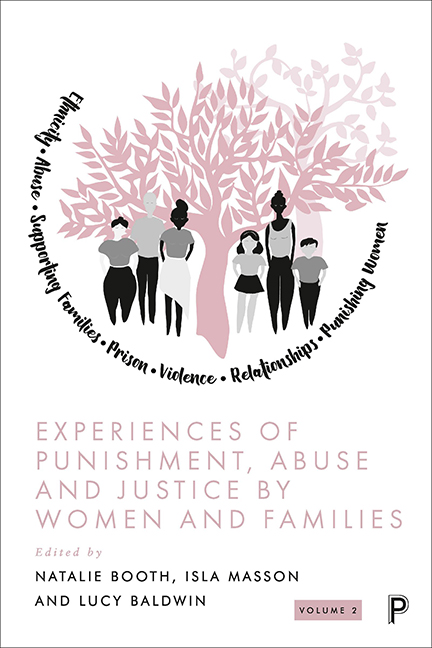Book contents
- Frontmatter
- Contents
- Notes on contributors
- Acknowledgements
- Foreword: time to shift the focus and reduce the use of the penal system for women
- 1 Keeping the conversation going: the Women, Family, Crime and Justice network
- Part I Punishing women in the criminal justice system
- Part II Violence, abuse and justice
- Index
Foreword: time to shift the focus and reduce the use of the penal system for women
Published online by Cambridge University Press: 18 January 2024
- Frontmatter
- Contents
- Notes on contributors
- Acknowledgements
- Foreword: time to shift the focus and reduce the use of the penal system for women
- 1 Keeping the conversation going: the Women, Family, Crime and Justice network
- Part I Punishing women in the criminal justice system
- Part II Violence, abuse and justice
- Index
Summary
More than 30 years ago I started working in penal reform. For the entirety of this time women have represented around 5 per cent of the prison population of England and Wales (House of Commons Library, 2021). Yet this, as all commentators on the criminal justice system (CJS) know, is just the tip of the iceberg, with thousands of other women directly affected by the penal system through community sentences or supporting other family members. Despite the best efforts of academic research, practitioner concerns, parliamentary scrutiny and campaigners like the Howard League for Penal Reform, this statistic seems intractable. But this should not be so.
In recent times there has been much political interest in women in the CJS. The Female Offender Strategy (FOS) (Ministry of Justice [MoJ], 2018) aimed to shift the focus away from the penal system through earlier intervention and community support, and community sentences rather than prison sentences (especially short ones). It also sought to create better conditions for women in custody, for example, by improving and maintaining family ties, reducing self-harm and providing better support on release. Yet several years on there seems to be little progress. The recent National Audit Office report (2022) found it hard to establish what progress had been made. In part, this was due to the lack of clarity in the initial plan – for instance, actions mixed into narrative, a lack of public-facing information and a lack of inter-governmental department working.
Perplexingly, the Prisons Strategy White Paper (MoJ, 2021) seemed to take the opposite tack to the FOS (MoJ, 2018) by focusing on investing in prisons and expanding their capacity. For women this included the announcement of 500 more prison places. In the foreword to the White Paper, the then Justice Secretary Dominic Raab sought views on ‘how the proposals can bring down stubbornly high rates of reoffending, cut crime and protect the public from harm’. Yet the plans don’t stack up: they do not allow for the development of regimes with time out of cell to ensure there are opportunities to socialise, receive visits from their loved ones and take part in meaningful work and/or education – all factors which are known to support effective reintegration into communities and increase the potential of women living a crime-free life following prison.
- Type
- Chapter
- Information
- Experiences of Punishment, Abuse and Justice by Women and FamiliesVolume 2, pp. x - xiiPublisher: Bristol University PressPrint publication year: 2023

